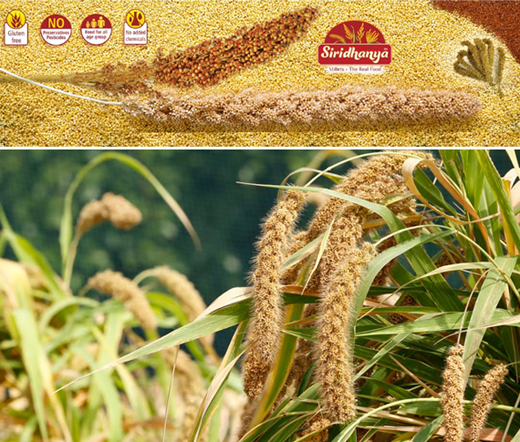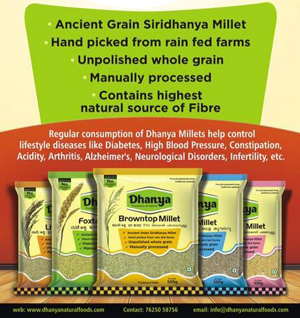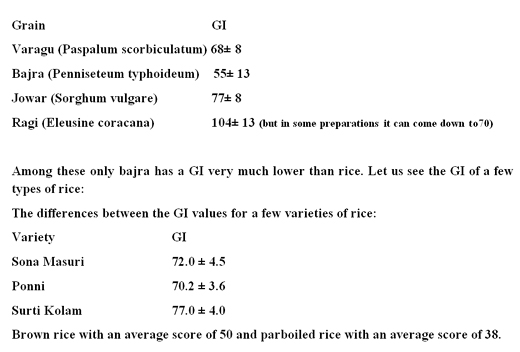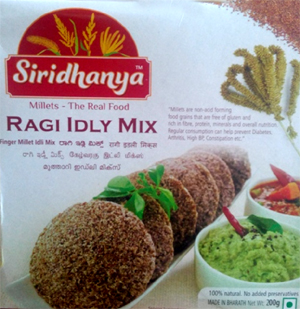Siri Dhanyas - Are they really the answer to diabetics?
Siri Dhanyas - Are they really the answer to diabetics?
Mangalore Today News Network
By Prof. Narendra Nayak
Mangaluru, June 24, 2017: Recently a lot of so-called specialists have been delivering gratuitous advice to diabetics about what to eat and misleading them with information which is supposedly authentic. Since some of them prefix ‘Dr.’ to their names, it creates an impression that they are physicians following systems of modern evidence based medicine. Their narratives are also with incidents like - how I advice many patients who come to me…… and so on.

They create scare with ‘sugar’ and confusing between sucrose, glucose and carbohydrates in general and so on. Those who fall for their traps are mainly those diabetics who are confused, and like all diabetics, hope for a cure for their problem by eradicating it from the ‘roots’ after which they can eat what they want as much as they want like in their pre-diabetic days. Disturbed by the very thought of following a diet or taking treatment for life they tend to swallow all sorts of weird theories peppered with apparently ‘scientific’ data - more importantly, jargon - they tend to ignore the advice of their physicians and follow these vendors of panaceas. The recent plugging of the so called Siri Dhanyas is a shining example of this. The proponents of this tend to combine their advertisements as advice for the gullible along with ‘organic’ farming, yoga, meditation, Satvik food and of course the hidden agenda!
It is not enough for people to plug those things they have to also criticize the so called ‘modern trends’ in order to make their wares look even better. Well let us take a look at their terminology: Sugar for them is cane sugar, which is sucrose, a disaccharide made up of two mono saccharides - glucose and fructose. For them sugar also means glucose only and confuse the people with that. While sucrose is a source of energy the problem with it is with its composition. More than that, the problem is with the 50% fructose component, which cannot be used for energy generation in the body except in very small amounts. It is metabolized only in the liver for fat synthesis. So, one is advised to limit its consumption.
This is twisted to make it look as if cane sugar available in the market is the only bad thing and jaggery is good. Besides tales are cooked up about how bone is added to decolorize boiled cane juice to extract sugar, how toxic chemicals are used to bleach it and so on. People do not understand that, this too contains the same disaccharide sucrose and it is metabolised in the same way as the one in table sugar - whether from sugar cane or from beet or any other source of it.
The glycemic index of sucrose is less than that of jaggery though both are on the higher side. For those who may not know - the glycemic index of a food is its comparison with glucose in increasing blood glucose levels. The lower the glycemic index more slowly is the entry of glucose into the blood stream from the intestine when the particular item is consumed orally. It should be recalled here that most of the carbohydrates in our food are in the form of starch which is digested to glucose before it is absorbed. Well while a detailed discussion on diabetes is beyond the scope of this let us understand that the rapid increase in blood glucose due to a rush of glucose rich blood to the pancreas after absorption of glucose from the digested food results in an increased secretion of insulin which leads to a lot of other things like lipogenesis etc. In diabetics when the pancreas is unable to secrete enough insulin due to many reasons or the insulin cannot have the effect on the end organs the blood glucose rises and this causes the complications of diabetes. If the food material has a lower glycemic index the glucose will be absorbed more slowly and this causes only a slow gradual increase in blood glucose levels. This in essence is the rationale behind advising foods with a lower glycemic index referred to henceforth as GI. Another point in the diatribes of some of these so called experts is addressing sugar or glucose as if it is a poison. Though the discussion of the details of the metabolism of glucose in the human body is beyond the scope of this, it would do well to understand that most of the energy needs of the body of the body are met by glucose and some cells like red blood corpuscles can use only glucose for energy. The brain also mostly uses glucose though it can adapt itself to use of ketone bodies formed from breakdown of fat stored in the body during prolonged starvation. There are many things to be considered about food other than this GI. The total calories are also important, the type of fat, protein, vitamins, minerals etc. But, let us examine only the carbohydrate part most of which enters the mouth as starch. There are others like sucrose, lactose(milk sugar) etc. Free glucose is present in a few materials like corn syrup, honey as such. Otherwise it will be a component of a compound-say starch which is a polysaccharide made up of thousands of glucose molecules linked together by chemical bonds, which must be hydrolyzed for breakdown to glucose which can be absorbed. The rate at which it is absorbed depends on a number of factors including the other components of the meal, the emptying time etc. One of the claims of the Siri Dhanya lobby is that these are low GI. Let us take a look at a few of them:
There are many things to be considered about food other than this GI. The total calories are also important, the type of fat, protein, vitamins, minerals etc. But, let us examine only the carbohydrate part most of which enters the mouth as starch. There are others like sucrose, lactose(milk sugar) etc. Free glucose is present in a few materials like corn syrup, honey as such. Otherwise it will be a component of a compound-say starch which is a polysaccharide made up of thousands of glucose molecules linked together by chemical bonds, which must be hydrolyzed for breakdown to glucose which can be absorbed. The rate at which it is absorbed depends on a number of factors including the other components of the meal, the emptying time etc. One of the claims of the Siri Dhanya lobby is that these are low GI. Let us take a look at a few of them:

So, consumption of parboiled rice is better for diabetics than any of the so called Siri Dhanyas! Now let us take a look at the GI of a few milk products including ice cream:
Milk product GI
Ice cream, premium 38
Milk, full-fat, average 31
Milk, skim, average 31
Reduced-fat yogurt with fruit 33
So does it mean that eating ice cream is better than Siri Dhanyas? Well we have to see about the rest of constituents too. That is total carbohydrate content, fat and protein also. Some of the fruits have a low glycemic index and are highly praised for that under the premise that though they are sweet the blood glucose does not increase much, conveniently forgetting that the fructose content in them can cause various lipid abnormalities like increase in VLDL. Anyway a detailed discussion on that is beyond the scope of this write up. While protein is beneficial the fat can add to calories and cause other problems! In those areas the Siri Dhanyas do not show much promise. They have total carbohydrate content a little less than rice and marginally more fiber. This what Dr.Shrinivas Kakkilaya, a physician of nearly three decades of experience of practicing rational medicine has to say about them:
 "Siri Dhanyas or Rich grains are nothing but millets, like Ragi, the finger millet. They have suddenly become a fad – after Yoga as a cure for all ills, now it’s the time for the Siri Dhanyas as the wonders to prevent and cure all ills. But just as Yoga is neither true yoga, nor is a prevention nor a cure for any ills, the Siri Dhanyas have no Siri, and no preventive or curative properties against any diseases. Only the selling middle men will become Srivanta or rich!All these grains are millets - pearl millet (Sajje, Bajra), Barnyard millet (oodalu in Kannada), foxtail millet (navane), Kodo millet (arka or haaraka), Proso millet (baragu), little millet (saame) etc. And like ragi, all these millets have carbohydrate content ranging from 61-70%, about 4-10% less than that of rice and wheat. The caloric content, fiber content and protein content of these millets are also comparable to those of rice, wheat and corn, with only minimal differences. Therefore, terming these millets as extraordinary, or as nutritionally superior to rice or wheat is wrong and totally misleading. (In comparison, most vegetables have carbohydrate content of 1-3%) Consumption of these millets will neither prevent any disease, particularly diabetes, nor will help in the control or treatment of any disease, including diabetes. Moreover, there is no evidence to prove that these millets can prevent or cure any illness."
"Siri Dhanyas or Rich grains are nothing but millets, like Ragi, the finger millet. They have suddenly become a fad – after Yoga as a cure for all ills, now it’s the time for the Siri Dhanyas as the wonders to prevent and cure all ills. But just as Yoga is neither true yoga, nor is a prevention nor a cure for any ills, the Siri Dhanyas have no Siri, and no preventive or curative properties against any diseases. Only the selling middle men will become Srivanta or rich!All these grains are millets - pearl millet (Sajje, Bajra), Barnyard millet (oodalu in Kannada), foxtail millet (navane), Kodo millet (arka or haaraka), Proso millet (baragu), little millet (saame) etc. And like ragi, all these millets have carbohydrate content ranging from 61-70%, about 4-10% less than that of rice and wheat. The caloric content, fiber content and protein content of these millets are also comparable to those of rice, wheat and corn, with only minimal differences. Therefore, terming these millets as extraordinary, or as nutritionally superior to rice or wheat is wrong and totally misleading. (In comparison, most vegetables have carbohydrate content of 1-3%) Consumption of these millets will neither prevent any disease, particularly diabetes, nor will help in the control or treatment of any disease, including diabetes. Moreover, there is no evidence to prove that these millets can prevent or cure any illness."
But these are quite expensive costing around 100 rupees per kilogram. To be fair these need far less water than rice and are drought resistant. Just because of that it does not mean that they are panaceas.
When this is the case we have our pseudo ‘doctors’ singing praises of them and promising full cures for diabetes within six months of consuming them. They have started co-operatives for selling them and many diabetics think of them as a substitute for medical advice and treatment. They have created monopolies for the sales of these grains and are certainly the middlemen are becoming rich living up to the name of siri(rich) dhanyas.
Let diabetics be aware that all cases cannot be managed by diet alone. Those Type 2 diabetics whose glucose levels are not under control need proper medical advice and treatment which is best decided by a physician qualified and trained in the field. Those so called self styled ‘therapists’ who talk about how their pet fad can cure every disease under the sun, moon and stars are not even aware of the fundamentals of processes that cause the disease.. It would do well for the diabetic patient to remember that their disease is not something which kills you on the spot or in a few days. The problem is because of the long term effects of glycosylation of proteins by increased levels of glucose and also the disorders of lipid metabolism. These could lead to complications in almost all of the organs. So, it is best for one to remember these things. I am not writing this for scare mongering or for plugging any practitioner. Whether to follow a rational path supported by evidence or go by myths propagated by some is a decision for the patient to take. We can only point out the facts.
- New Synthetic Drugs Trapping Youth
- Mood Modifying Chips - Future of Drug Use
- Ramping up Indo-Bangla border security
- IITM- A premier educational Institution in a forest. What can we learn?
- Former PM, Manmohan Singh: Notable laws passed under his tenure
- Hashish on Ratnagiri Seashore
- The Poor cry out to Us: Do we respond?
- Clandestine Meth Labs Sprouting Across India
- Hydro ganja from Bangkok latest craze among youth in India
- "Memories to Treasure" Dr.Michael Lobo’s new book
- Dominance of Private Universities: Will it make education inaccessible to underprivileged students?
- Monti Phest: A rich heritage of South Canara
- When jails become drug dens
- Kashmir Bhavan in Bengaluru: A must visit place
- "MAI and I" Book of Angelic Emotions
- Draupadi Murmu - The New ’President of India’
- Anthony Ashram in the city grows a classic museum
- First College of Fisheries in India - A Golden Jubilarian
- Flushing Meadows - A Vintage Mansion
- The Colonel�s Bequest
- A Mangalorean PM and his RBI Governor Brother: The Extraordinary story of the Benegal Brothers
- There is no higher religion than Truth: Theosophical Society
- L�affaire - Ashu & Yiju of Mangalore
- Mangalore in Kowloon
- 1568 to 2018 AD: 450 years of Christianity in Mangaluru
- Vice President elect Naidu moves on from nadir to zenith, the phenomenal journey
- Embracing the Outdoors: How Heated Jackets Are Revolutionizing Cold Weather Activities
- Efficient and Sustainable Packaging Solutions with FIBCs
- The Hybrid Kilt Revolution | Where Tradition Gets Trendy
- Affordable Elegance | Embrace Style on a Budget with Cheap Kilts
- Unleashing Style and Functionality | Exploring Tactical Kilts
- Mangalore’s Heroic Lady marks 105th Birthday
- Santa the Christmas spirit
- Geriatric care: Mangalore strikes a fine balance
- The Don Who Made Two Empires to Clash
- CHITRAPUR SARASWATS - A Great Kanara Community
- Our new President Ram Nath Kovind’s significant journey to Rashtrapathi Bhavan
- Marriages made in heaven, big fat weddings made in India
- Eid insight - The giver of glad tidings
- CITY INFORMATION
- TRAVEL
- TOURIST INFORMATION
- HEALTH CARE
- MISCELLANEOUS



 Write Comment
Write Comment E-Mail To a Friend
E-Mail To a Friend Facebook
Facebook Twitter
Twitter  Print
Print 


